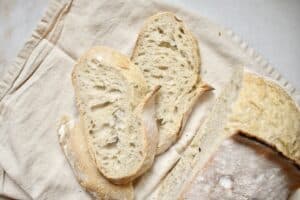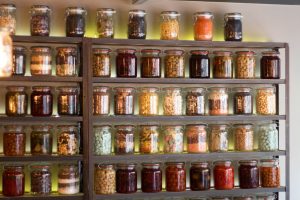I had heard that the third week on GAPS was supposed to be the week I started to feel better. I went into week 3 with high expectations. And while I did get to incorporate some new foods, and my gut held steady (no pain, no cramps, no distress other than the usual bloating and distension), I did not find myself to be suddenly in a place of health and wellness (darnit).
I spent my third week of GAPS finishing out Stage 2 of the Introduction Diet. Having gotten through the egg challenges of the previous week, I proceeded on with egg yolks, but no whites. The next item on the list?
Stew!!

Glory be! Something other than soup! Have you ever eaten soup for every single meal for two weeks?? Can you even imagine the joy of sticking a fork into something???
I know that photo may still look quite soup-y, it is a fine line between soup and stew, but those chunks of veggies were heaven in my mouth. And, I must confess, that first stew I made was quite delicious (I’ve posted my best attempt at a “recipe” below).
In preparation for making stews, I knew I’d need a good source of animal fat. I considered my options–beef tallow, chicken fat, or ghee. Since ghee is technically a dairy product and I haven’t introduced dairy yet, I decided against that one. The chicken fat I was getting from my broth was being stirred back into the soup. So I went with the beef tallow. Yes, my friends, I have rendered beef fat.
I’ve had one previous encounter with rendering tallow, and it didn’t go that well. I was just a bit hesitant to try it again. But it went better this time. And I think I have the kinks worked out so that next time will be perfect.
In case you, too, are feeling a need to render some tallow, here’s how to do it.
- Source some beef suet from a butcher–the more organic and grass-fed the better. This may require some searching, and you may need to explore smaller, more local butchers to find it. But it is gloriously inexpensive.
- Chop the suet into small chunks. Make your chunks much smaller than the ones in the photo. The smaller your chunks, the more tallow you’ll get out of them.
- Place the suet into a heavy pot, either in a low oven (200 degrees or so) or on a low burner. You want a slow and gentle heat. Leave it alone for a while. The tallow will begin to melt out of the chunks. It may look sort of tan colored, but don’t worry. If your heat is low, it’s not burning. When it solidifies it’ll be creamy white.
- There will be some solids left behind. When these are fried golden brown and crispy, remove them with a slotted spoon. These are “cracklin’s” and they are delicious mixed into cornbread. You can save them if you want. Or if you’re kinda grossed out by them you can throw them away.
- Carefully–so very carefully–pour the tallow into a glass jar. Leave to cool. Store at room temperature. Tallow is a very stable fat so it’s good for high heat cooking like sauteeing and frying.
To make a GAPS stew, cook up your desired meat (ground beef, diced chicken, shredded chicken, etc.) in a very generous amount of animal fat, such as tallow. You could also use coconut oil or ghee, if tolerated. In my kitchen, if I’m making a chicken stew I use coconut oil, and if I’m making a beef stew I use tallow. Once your meat is cooked, add in a slew of veggies. I know that “slew” does not really provide a precise measurement for you. I shoot for about 10-12 cups chopped veggies for each pound of meat. Once your veggies are in the pot, add water or broth to cover all but the top two inches or so of the meat and veggies. Simmer until the veggies are soft and melty.
Stews do not actually replace the soup at this stage. You still need to eat lots and lots of soup. The broth is essential for your healing. While on Stage 2, I continued with soup for half of my meals. Ideally you would also sip some broth throughout the day.
Once you’ve managed stew, you can try a casserole. This turns out something like a cottage pie, or a shepherd’s pie. You transfer your stew into a casserole dish, and then top it with mashed cauliflower. The cauliflower forms a sort of “faux-tato” topping. Unfortunately, my belly wasn’t ready for cauliflower, so while I found the casserole I made to be quite delightful, I haven’t made another one.
Throughout all of these various soups and stews, I continued adding a new veggie every day or two. Some of them worked out great (mushrooms, peeled and seeded tomatoes, spinach). Others I had to take out again (green beans, broccoli).
Once I had the stews and casseroles figured out, I increased the amount of “juice” I was taking from my fermented veggies. I started my diet with 1 teaspoon per day, increased to 2 teaspoons in week 2, and increased to 3 teaspoons in week 3. This increase didn’t give me any troubles.
Up next, fermented fish. Can you even believe that this is part of my regular diet??
I didn’t feel up to making it myself, so I again hired my lovely friend to do it for me. I confess to being excited to try it, just because it’s so darn weird and I was dying of curiosity. Allow me to relieve your curiosity–rotten fish tastes like….rotten fish. At first I was excited just to have a new flavor in my diet, but it hasn’t grown on me. After a few days of fermented fish I began holding my nose to get it down.
Now you may well ask yourself, as any sane person would, why…why would one eat rotten fish? I asked myself the same question (and my Sweetie Pie husband asked me, too, while making disgusted faces at me) While I knew the benefits of anything fermented, I didn’t know why, in heaven’s name, I had to eat fermented fish.
I spent a fair amount of time mining Google results to find the answers, but it was tricky. Most search results were scientific studies based on livestock that I couldn’t understand or access. The best information I could come up with, both of which completely make sense to me, is this:
First, fish is chock full of many nutrients, minerals, and fats. Many of these beneficial elements are altered or destroyed by cooking. In eating the fish “raw”, you are preserving all of the nutrition of the fish.
Second, protein is an essential part of healing a compromised digestive system. In order to rebuild cellular structure in your body, you must have protein. However, protein is also very difficult to digest on a compromised digestive system. The ultimate gotcha. You can eat all the protein you want, but your body can’t digest it nor put it to proper use.
Fermentation is a sort of pre-digestive process. It breaks down the structures of the food, preserving the nutrients and making them more easily digested and more bioavailable to your body. So by consuming the fermented fish I’m giving my belly a form of protein that can be easily and immediately utilized by my body to rebuild my intestinal lining. Okay, reason enough for me to drop a piece of rotten fish down my gullet once a day.
I completed Stage 2 by incorporating ghee into my soup and stew. Ghee is butter with all of the protein solids removed. You may have heard Martha Stewart refer to “clarified butter”. She’s referring to ghee. It’s super simple to make, but I had a jar in the back of the fridge from my Indian cooking days and have been using that. I was pleased to find that while my body objects to dairy, it accepted ghee just fine.
Here’s what my diet looked like for Week 3 (Stage 2 of Intro)
- continued all foods from Stage 1 (soups, ginger-lemon tea, “juice” from fermented veggies)
- continued with egg yolks added to soups and stews–about 5 a day
- introduced stew and casserole, adding new veggies every day or two. I removed the casserole because my body didn’t seem to enjoy the cauliflower “faux-tatoes”.
- introduced fermented fish; my friend used fresh sardines for my batch. There are a variety of recipes in the GAPS book and on the web using other types of fish.
- introduced ghee
My supplements remained the same
- Hydrochloric acid before meals; I began Week 3 taking 3 capsules before meals and by the end of the week was able to reduce it to 2. An encouraging sign!
- Probiotic–a half dose in the morning and a half dose in the evening
- prescription meds for ulcerative colitis
And finally, I still continue my nightly detox bath, a routine that I have grown to adore. It not only helps keep my die-off symptoms under control, but is also an immensely soothing way to end my day.
And how did I feel? Meh.
I had a day or two of energy, when I was able to enjoy being outside with the kiddos or able to catch up on laundry or cooking, but I still required an hour or so of rest time in the afternoon. The synapses in my brain continued to fire on a very low speed, resulting in a certain amount of fogginess and lazy-thinking.
I had another pain-free week, which is reason for celebration. And while my gut still does voice some complaints–mostly in the form of bloating and distension–it is overall in a much better place than it was a month ago.
So, I guess I’m sticking it out for another week. Stage 3, here I come.
Basic Stew
This is my best guess at a “recipe” for the first GAPS stew I made. It’s infinitely adaptable. Substitute veggies and herbs as desired.
Ingredients
- 1/4 cup coconut oil
- 1 zucchini peeled and seeded, cut into chunks
- 6 carrots cut into chunks
- 1 kabocha sqaush peeled and seeded, cut into chunks
- 6 tomatoes peeled and seeded, cut into chunks
- 1/2 pound mushrooms quartered
- 1/2 cup fresh parsley chopped
- 1 sprig fresh rosemary chopped
- 1 Tbs fresh thyme chopped
- 2 Tbs fresh sage chopped
- 2 pounds organic chicken thighs skin-on and bone-in
- water or chicken broth
- sea salt
Directions
- Melt the coconut oil in a crockpot. Add the veggies and stir together to mix well and coat with the oil.
- Place the chicken thighs on top of the veggies. Add water or homemade chicken broth to cover all but the top 2″ of the veggies and meat. Season with salt to taste.
- Cover and cook on low for 6-8 hours, or until chicken is done and the veggies are soft and melty.
- Remove the meat and the skin from the bones and mix into the veggies. (Reserve the bones for making broth)
- Serve as is, or with egg yolks or soft-boiled eggs mixed in for added nutrition.










